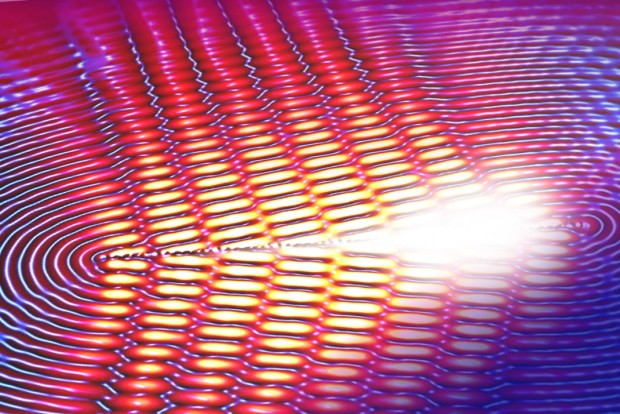Superradiance in Ultracold Molecular Samples
Physicist Susanne Yelin on atomic decay, wave interference, and ultracold polymolecules

Xingjie Ni is Charles H. Fetter Assistant Professor at the Department of Electrical Engineering of Pennsylvania State University. Serious Science has asked Dr. Ni to speak on the subject of nanophotonics and one of the most exciting developments in this field – the ‘invisibility cloak’.
What is your laboratory working on?
My lab is mainly working on nanophotonics, plasmonics, and optoelectronics. We design and engineer nanostructures – structures that are extremely small – tens of nanometers or hundreds of nanometers made of all kinds of materials. Those nanostructures interact differently with lightas the original materials. For example,glass is usually transparent, but if it is made into nano-particle arrays, the optical property will be entirely different – it will look white or another different color depending on the size and the shape of the structure. We use this concept to artificially engineer the nanostructures so that we can manipulate the light-matter interaction at will.
We can make these artificial materials – or metamaterials – with extreme properties or unique properties that no natural material can have. For example, a material can have a very low –even close to zero – refractive index. We can push even further and make the refractive index negative. We can make the nanostructure very thin, so it becomes an artificial surface – or a metasurface– that controls the light properties, for example, phase, amplitude, polarization and so on,directly. And apart from being phenomenologically interesting, these structures also have very useful applications. For instance, you can use it to make extremely thin lenses and wave-plates which can replace the current bulky ones. We can also demonstrate unparalleled physical phenomena, such as quantum interference,using metasurfaces.
One of your recent developments is the ‘invisibility cloak’. How does it work?
The invisibility cloak we created is using the same concept –engineering the optical propertiesof the material in the nanoscale. We placed tiny brick-like nanostructures –we call them ‘nanoantennas’ –on top of a3D object. These nanoantennas have some unique properties – they resonant with the incoming light and scatter it afterwards.We designed the nanoantennas so that the antennas modify the phase of the scattered light while maintaining the similar light intensity. And we have a set of nanoantennas cover all the phases from 0 to 2pi. We put them onto the object and based on the location we choose a specific nanoantenna to recover the phase that is distorted by the object.
Seeing an object is not like touching the object – Once light scattered by the object reaches the eyes, the brain interprets the appearance, shape and location with the encoded information. When the nanoantennas recover the distortion caused by the object, the information about the object is erased. What you see is just a flat surface. That is how our device works –If you shine light on it, it will look completely flat and blended into the surrounding, free from optical detection.

In fact, people already worked on something similar in the past –carpet cloaks, which reroute the light inside a bulk engineered material. The object is hidden underneath a designated region and the carpet cloakdoes something similar – it realigns the wave-front and make it as if it were a mirror. However, there are critical limitations to these cloaks: they are bulky – you need a very thick material to cover that object in order to have enough room to bend the light. This also causes a problem that the device is hard to scale up – it is not a problem in the lab because we can make a very smallcloak to demonstrate the effects, but in reality you do not want your cloak to be just microscopic.
Another limitation concerns the light phase – we have nanoantennas which allow us to manipulate the phase from 0 to 2pi and thus cover all the phase domain. So for the previous cloak, although they can realign the light wave-front –as if the light was not scattered – but if you look at the phase it will still have difference between the really reflected light and the light that goesthrough the cloak. With a phase-sensitive detector, you can sense the difference. This defeats the cloak, because you can see that there is some distortion, and therefore you know there is something hidden.On the contrary, our cloak can freely manipulate the phase and it fully recovers the phase. Because of that the object remains hidden even if a phase-sensitive device is used.
Our cloak wraps around a 3D object conformally, which has not been demonstrated before. Our cloak – we call it a ‘skin cloak’ -is extremely thin. It is easy for fabrication. You can build it using the standard technique –the same procedures as when you are making computer chips. It does not need a 3D fabrication.Essentially it can be made very large – there is no scalability problem. Theoretically it can be made to cover a macroscopic object.
It is a new concept – to make a cloak with very thin material – an artificially engineered surface, and make it conformally wraps around some object like a cloth or a paper. The best advantage is the fact that we solved this phase problem – so that phase-sensitive detection does not defeat the cloak. And it is fully scalable and easy to fabricate with two-dimensional fabrication techniques.
And these antennas that you use – what are they made of? What is their structure?
These are two layers of the cloak. The ‘spacer layer’ –a gap between the back-plate and the nanoantennas– is made of magnesium fluoride. It is a transparent dielectric material, which people use to make optical coatings for lenses. The nanoantennas are made of gold – they are brick-like with squares on the top, and by varying the dimensions of the square you can vary the phase. That’s the only two materials that we use in our device.
Why do you use these materials? What properties do they have that allow for that function?
That’s an interesting question. Magnesium fluoride has a very low refractory index, which is important for our design. As for gold, it belongs to a group that we call ‘plasmonic materials’ – metals, like gold, silver, copper. An interesting thing about them is that if you shine light on them, the free electrons inside the material will oscillate collectively. These oscillations we call plasmon oscillations, and this effect is called the plasmonic effect. A nice thing about these materials is that they can create very strong resonances and localize light into subwavelength dimensions.They are suitable materials for us because the nanoantennas made of them scatter the light efficiently and react strongly.
What applications may be for the cloak in its current state?
First thing of which many people think is: if you can make something invisible it can be used for military purposes, for example, on the battlefield you can make a soldier or a vehicle invisible, increasing the survival chances. I admit that it can be one of the applications, but there are many others. One application might be in cosmetics. You can imagine if someone has a birthmark, for example, which they don’t want to remove by surgery – in this case they can just cover it with an invisibility tissue to make it disappear. Or maybe some people have fat bellies and they wants to look nice, they could put this layer on which makes them look fit. This may be a wild thinking, but it may happen in the future.
To make something invisible is interesting, but this technique is even more interesting in terms of science and technology. Basically we made a device that has total control over amplitude and the phase of the light, and if you cover a surface with it, the optical properties of the surface will be completely changedby these small elements. The fact that we can make a curved surface appear flat also means that we can make a flat surface appears curved. For example, you can make a sculpture or some other piece of art for decoration without actually havingthebulky material. It can also potentially have huge impact in the 3D display industry.
What are the current limitations in the function of your cloak?
Because it is a completely new concept – we are the first ones who demonstrated this effect using this type of a device – there are some limitations we are trying to overcome. One of them is that although conceptually it is fully scalable, but it is limited by the current state of fabrication technology. Because if you want to make such large pattern area, first of all, it will be extremely expensive, and second, you need to have a technology that can handle that size. Fortunately, we have a technology that is called ‘roll-to-roll nanoimprinting’, which can potentially scale up our device.
The other limitation that we have is that our device does not have a very large reception angle.In other words, the the object is hidden only if you look at it within certain angle range. If you look at the object in a very flat perspective angleand if the object is standing out of the surface, it is going to block the light and you will see the shadow.
What inspired you to do the research on the invisibility cloak and not on something else?
First of all, many people, including me, are fascinated by the invisibility cloaking device. People are talking about it and imagining it in movies and novels –like ‘Star Trek’ and ‘Harry Potter’. It demands to make a real one.
What other promising studies are there in the field of nanophotonics?
Nanophotonics is a very big area. My research is using nanostructures to control the light interacting with materials and study novel physical phenomena during the interaction, for example, we study new materials which can mimic some interesting physical phenomena, like spin Hall effect. Also, there are researchers trying to integrate photonic devices into a chip for communication and even computation. They build tiny optical waveguides, modulators, and on-chip lasers. People also study quantum effect when light is confined in the nanometer scale. Moreover, nanophotonics also have influence on other fields, such as biology, for which researchers make high-resolution imaging devices, even super-resolution imaging systems that break the limit of diffraction.
What is the future of the invisibility cloak research and of the field of nanophotonics in general?
As I said before, our cloak has some limitations, we are working hard trying to overcome them and to further improve the cloak. These still is a long way to go for this device to become macroscopic and to become affordable.
These is a lot of research going on trying to get this nanofabrication technology to be more advanced to handle larger devices and how to improve the design to overcome the limitations. I think, as technology advances, these problems can be solved one-by-one and these sci-fi devices will become a part of everyone’s daily life.
Nanophotonics is a natural outcome of people’s curiosity for smaller and smaller photonic systems. Nowadays the demands are greater than ever before for communication speed, energy, imaging resolution, and etc. How to transmit information faster, how to collect solar energy more efficiently, how to see smaller things directly – for these questions, the answer may lay in the research of the nanophotonics.

Physicist Susanne Yelin on atomic decay, wave interference, and ultracold polymolecules

Computer scientist Matthew Bass on dynamic environment, multitenancy, and coordination between releases

The new research suggests that deep water layers may have played a role in ending the last glacial period in t...